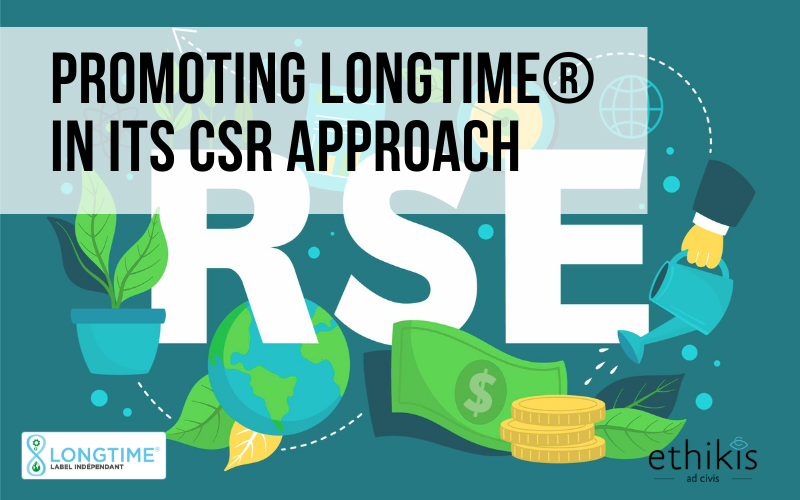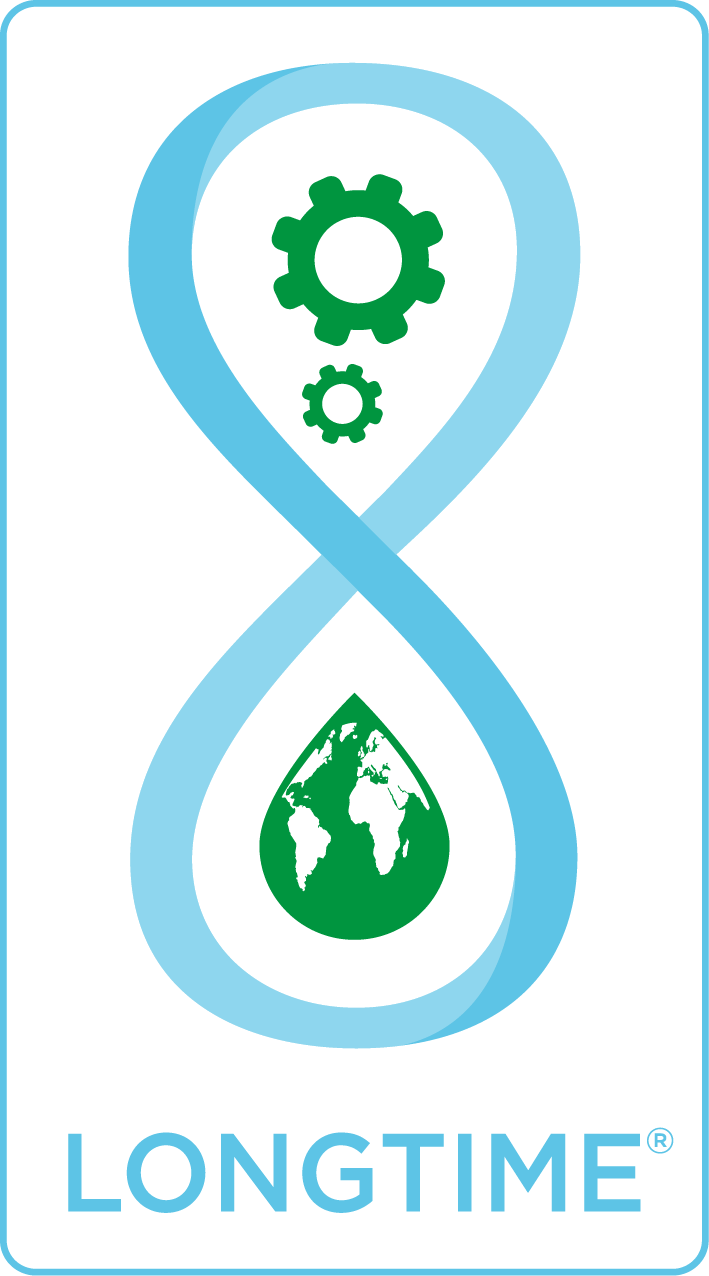
As we shall see in this article, the concepts of CSR and sustainability are very closely linked. As a result, once certification has been obtained, it can be very useful to include a sustainability label such as LONGTIME® in your CSR approach.
How do you explain CSR simply?
To explain CSR, we first need to define it: an acronym for Corporate Social Responsibility.
A relatively recent concept, it is closely linked to the concept of Sustainable Development, and can be seen as a code of conduct for achieving sustainable development objectives.
CSR is a set of initiatives and guidelines that enable an entity to develop its business while respecting the environment and the well-being of its peers.
This notion of seeking the common good is far from recent. It has existed since the very beginnings of human development, through communication, mutual aid, taking everyone’s opinion into account, and respect for others and the environment. In other words, to put it succinctly, CSR is the contribution made by companies to the challenges of sustainable development.
As far as related texts are concerned, there is the ISO 26000 standard, for example, which sets out the main principles and guidelines for developing your organisation’s CSR in practical terms. The majority of companies are beginning to realise the importance of developing this responsible vision, whether in terms of social challenges, brand image, marketing, economic or deeply altruistic reasons.
What tools are available to support CSR development?
There are a number of tools available to provide concrete solutions and support structures in developing their CSR code of conduct:
CSR consulting, CSR training, self-diagnosis, CSR and extra-financial reporting tools, LCA, carbon footprint, CSR management software, standards, eco-design support… Unfortunately, most of these tools are unsuitable for small organisations because of their cost and the human resources/training they require. There are also a number of CSR labels that can help companies structure their approach while promoting their actions. Here are just a few: engagé RSE, Bcorp, écovadis, Label Numérique Responsable, Positive Workplace.
The business model of a label is based on annual fees, the amount of which is a percentage of the turnover achieved by the labelled structure. These fees are usually capped at around ten thousand euros a year, and start at a few hundred euros for organisations with the lowest turnover. The labels are therefore suitable for large organisations, as well as for small and medium-sized enterprises and very small businesses in terms of cost;
How does the LONGTIME® label fit into your CSR approach?
LONGTIME® is an independent label for consumers. Born in France but with a European and even international scope, it was developed to encourage the manufacture and consumption of products that are more sustainable over time. By encouraging consumers to make better choices and manufacturers to produce more efficiently, LONGTIME® aims to contribute to the reduction of premature waste and the rational use of materials, while addressing related social challenges.
The LONGTIME® label encourages a circular economy and champions the repair sector, a skilled and local field of activity. Our activity gives everyone the means to take action to extend the life of products. LONGTIME® is a positive communication tool, a benchmark for product sustainability and a practical solution that promotes the extension of product life. The negative environmental externality associated with obsolescence is thus curbed.
If you’re reading this article, you may have already initiated a CSR strategy, and, whatever its level of development, you’re looking to improve or optimize it through appropriate actions and management. The CSR development framework is divided into 8 main stages.
Depending on how far along you are, these steps may hold no secrets for you, or, for others, certain steps may still need to be implemented.
Here’s a summary of how the LONGTIME® label can be integrated into each of these stages:
Stage 1: Definition of CSR scope and challenges, expectations and project team (with a designated CSR manager if possible).
Definition of the scope of products to be labelled with the help of the label teams.
Step 2: Carry out a diagnosis of practices and impacts, list activities (processes), potentially integrate CSR/QHSE, 9001 and 14001.
An internal diagnostic tool is available on our website to help you assess your sustainability performance.
Stage 3: Stakeholder consultations :
Stakeholder relations are at the heart of a corporate social responsibility code of conduct. The labelling process involves in-depth dialogue with the producer’s stakeholders (distributors, suppliers, subcontractors, in-house technical teams, design office, after-sales service, etc.). We can help you to focus these discussions as effectively as possible.
Step 4: Create one or more Materiality Matrices to identify stakeholder expectations.
You can draw up your materiality matrix with regard to the sustainability of your products, following consultation with your stakeholders.
Step 5: Prioritize guidelines and budget management.
The cost associated with a LONGTIME® certification process is fully adapted to your organization’s sales, so that the associated budget is consistent.
Step 6: Define an action plan to engage teams and train them if necessary.
The LONGTIME® label teams will work with you to raise your teams’ awareness of the sustainability and repairability of your products, and will support you step-by-step right up to the certification audit. This enables you to define a concrete action plan, defined in terms of time and key stages.
Step 7: Implement and manage actions and ensure follow-up using SMART (Specific, Measurable, Achievable, Realistic and Time-bound) indicators.
The LONGTIME® label teams provide you with an audit preparation and reporting tool, enabling you to track your progress using SMART indicators.
Step 8: Communicate and promote the approach, build or join a business network.
Once your product(s) has/have been awarded the LONGTIME® label, you can communicate its/their durability. You can also include LONGTIME® in your non-financial report. (second part of this article).
What areas of ISO 26000 action does the LONGTIME® label cover?
With its international approach, ISO 26000 backs the social responsibility of organizations with the recognition of universal principles.
What are the 7 core questions of CSR?
The ISO 26000 standard sets out guidelines based on 7 principles and 7 central questions, which form the basis for the operational development of an organization’s (or structure’s, company’s) societal (or social) responsibility and its contribution to sustainable development. The 7 core issues are: Organizational governance, Human rights, Labour practices, the Environment, Fair operating practices, Consumer issues, Community involvement and development The 7 Core Issues (such as human rights) are broken down into 36 Action Areas. Each Action Area is illustrated by around 300 Expectations and Associated Actions.
These 3 levels of construction give the organization a global vision of the issues to be addressed, and enable it to plan ahead with its employees. The LONGTIME® labeling process is based on 3 out of 7 central questions and more than 25 expectations and actions defined in the ISO 26000 standard! They are listed below:
- Core issue 1: Governance.
- Stakeholders are identified
- Dialogue with stakeholders is developed
- Employee participation is encouraged
- Strategic CSR projects are implemented to meet the objectives and challenges of
- Projects are assessed for their impact on CSR challenges
- A stakeholder communication strategy is established
- The company participates in independent certification programs
- Reports are assessed by independent, competent third parties
- Core issue 4: Environment.
- The manufacturer’s responsibility for resource use is extended to its sphere of influence.
- Sustainable consumption is promoted
- Focus on energy efficiency of purchased goods
- Suppliers using sustainable technologies are favored
- Core issue 6: Consumers.
- Product information is provided in the official language of the country.
- The product description is complete, accurate, comprehensible and comparable.
- Product compliance with regulations is checked
- Clear customer information accompanies the product
- Instructions specifying the product’s conditions of use are sent to the customer.
- Instructions for handling and storing the product are given to the customer
- A commitment to develop sustainable consumption is defined
- End-of-life products and packaging are easily reusable, repairable and recyclable.
- High-quality, long-lasting products at affordable prices
- A reference label such as ECOLABEL can be used to communicate CSR aspects.
- A commitment to efficient after-sales service is defined
- Product returns after purchase are allowed within a specified period.
- Guarantees going beyond the legal aspects are offered to the customer
- After-sales service and dispute procedures are easily accessible to the customer
- Technical assistance is offered to customers on how to use the product.
You now have a very concrete version of how the LONGTIME® labeling process fits in with the action areas and expectations of the ISO 26000 standard. Now, how can we effectively communicate the contribution of the LONGTIME® label to the expectations and actions listed above? One way of doing this is to include it in a non-financial or CSR report.
How do you write a non-financial report?
The non-financial report, also known as the CSR report or Extra-financial Performance Declaration, is a document used to communicate the social, environmental and governance aspects of a company’s activities. Large companies are required to draw up an Extra-financial Performance Declaration, while SMBs may do so voluntarily. In France, the law requires that listed companies with a total balance sheet of €20 million or net sales of €40 million and 500 employees, or unlisted companies.
